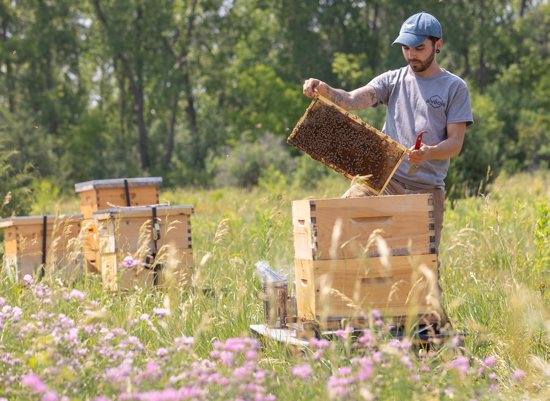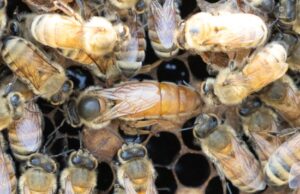
Beekeeper Kyle Hagberg spent time on a hot afternoon June 21 checking on hives in a section of Resurrection Cemetery in Mendota Heights, part of an initiative by The Catholic Cemeteries to implement principles found in Pope Francis’ 2015 encyclical “Laudato Si’: On Care for Our Common Home.”
Thousands of bees fly throughout a section of Resurrection each day, pollinating native flowers as they go, whimsically bringing to mind a Scripture verse found in 1 Corinthians: “Where, O death, is thy sting?” With the cemetery’s total 190 acres, the bees in this section will not be near any cemetery visitors, said Joan Gecik, executive director of The Catholic Cemeteries.
Using a small metal smoker to calm the insects, Hagberg pulls out several wooden frames without incident, despite not wearing gloves. Hagberg, 31, a beekeeper for six years, is a member of a local team from Chicago-based Alvéole, which works to bring bees and education about them to businesses, schools and various organizations to meet engagement and sustainability goals. The Alvéole team maintains hives at Resurrection and at Gethsemane in New Hope, also part of The Catholic Cemeteries. Gethsemane presently has 10 hives and Resurrection 14.
Both serve as metro area staging grounds for hives in early spring that are distributed to local business representatives who agree to have hives on their property. If bees at client sites experience health problems, their hives are brought to one of the cemeteries so beekeepers can give them resources from the other, healthy hives and monitor them more frequently.
Hives at other sites, such as the Minneapolis Convention Center plaza, are kept smaller on purpose “so that (the bees are) nice,” Hagberg said, meaning less defensive. “We keep the population a little bit smaller because we bring people out to the hives to meet the bees,” including during educational workshops. Smaller numbers of bees mean the bees “stay really friendly,” Hagberg said.
Larger hives at the cemeteries are not worrisome because “we’re beekeepers, we’re very comfortable working with bees that are a little bit more defensive,” he said.
The Catholic Cemeteries started working in spring 2022 with Alvéole, to place and maintain beehives at the two sites, and are adopting a number of ways to care for creation within the cemetery, Gecik said.
“We are doing a lot of pollinator grasses,” she said, overseeding a section and allowing grasses and flowers to grow. “It’s to preserve the earth and work with the pollinators.” The natural burial section at Resurrection is “Minnesota prairie,” Gecik said, not mowed and “very natural.”
 HELPING BEES
HELPING BEES
Updates and tips for helping bees are linked from The Catholic Cemeteries’ Facebook page. One recent post from Alvéole lists “a few ways to say thank you to all bees:
- Plant. More. FLOWERS!
- Create nesting habitats for native species. …
- Be mindful of the products you use on your lawn. Pesticides kill not only the pests when applied constantly or incorrectly. …”
Calvary Cemetery in St. Paul, another of The Catholic Cemeteries, is considering adding “some pollinator areas and maybe some gardens around the cemetery, Gecik said. “So, anything concerned with the environment, a lot of it comes from ‘Laudato Si’,’ because we are stewards of the earth for sure,” she said. “I think that’s part of what we’re called to do.”
Some ways to help the environment are simply about preservation, Gecik said. “There’s so much development and no more green space for a lot of animals, plants and insects,” she said. “We’re basically ‘concretizing’ them out of what was their land,” she said. Hosting the hives promotes using spaces “that could help protect the animals and insects, and it supports the environment,” Gecik said.
Resurrection has bluebird houses and visits from abundant wildlife, such as deer and turkeys, osprey, eagles, sandhill cranes, tundra swans, geese — and killdeer are nesting next to the building this year. “It’s a place of nature,” Gecik said. “Our new kind of motto is ‘the cemetery is alive.’”
The work of honeybees is vital to food supplies. The U.S. Department of Agriculture reported in June 2022 that honeybees are the main commercial pollinator in the U.S., with more than 100 U.S.-grown crops relying on honeybees and other pollinators, “including birds, moths, butterflies and other insects.” The pollinators play “a key role in ensuring we have an abundant food supply and a vibrant ecosystem,” according to the USDA, and they add more than $18 billion in revenue to crop production every year.
While Minnesota is home to more than 500 species of native bees, Italian honeybees are maintained at the two cemeteries because they are more “generalists,” Hagberg said, pollinating “a lot of different flowers, which is really good and useful,” while native bees only pollinate certain varieties. But native bees are about 300 times more efficient at pollinating, Hagberg said, “so it’s super important to keep the native pollinators around.”
The open spaces at the cemeteries are “just beautiful spots for the bees,” Hagberg said. “It’s basically everything you could ask for.” Bees like to be out in the open sun, especially in winter, he said. “And there’s lots of native prairie growth around that area,” with much in bloom for bees to eat.
Having native prairie habitat that blooms “is amazing for the bees and also for native pollinators,” Hagberg said. The bees have “lots of native flowers to forage off of, and … (cemetery staff) don’t spray any harsh chemicals, so they’re not contributing to any pesticide.” Hagberg said he always sees “a ton of insect life” at the cemeteries, which he doesn’t see everywhere.
Hairs on the bees’ legs are designed to grab pollen, and they “smooth that down to bring back to the hive,” Hagberg said. The rest of the pollen that attaches to their abdomen and body transfers to the stamens of each plant as they move from flower to flower, pollinating them as they collect their resources, he said. “It’s a beautifully symbiotic relationship that they have developed with the plants in order to provide for each other.”
In winter, the bees eat their honey and pollen, “and shake their wings and vibrate special muscles to keep the hive at about 95 degrees all winter,” Hagberg said.
In an article in the August 2022 issue of Catholic Cemetery magazine, Gecik wrote that shedding light on honeybees promotes the public’s attachment to them, ensuring “a commitment to all living beings as well as a transformed view of the environment.”
“We are not looking to go into the honey-producing business, but it is good to know that our cemeteries can be places to help sustain the environment even as we care for grieving families,” Gecik wrote.
‘LAUDATO SI’’ AND THE ARCHDIOCESE
The Center for Mission at the Archdiocese of St. Paul and Minneapolis is coordinating 15 to 20 two-hour listening sessions mid-August to September with Catholics across the archdiocese. Participants will be asked about “their experiences of the environment” and how those experiences relate to their faith and understanding of Catholic teaching on the environment.
Data gathered, reported anonymously by person and parish, will be used with other information to create a “Laudato Si’” action plan for the archdiocese. For details on dates and locations, watch for bulletin announcements and check online archdiocesan calendars in mid-July: www.thecatholicspirit.com/calendar and archspm.org/events.





